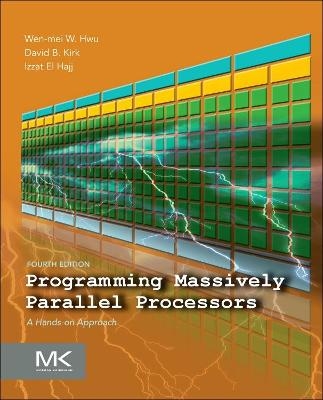
Programming Massively Parallel Processors
Morgan Kaufmann (Verlag)
978-0-323-91231-0 (ISBN)
Wen-mei W. Hwu is a Professor and holds the Sanders-AMD Endowed Chair in the Department of Electrical and Computer Engineering, University of Illinois at Urbana-Champaign. His research interests are in the area of architecture, implementation, compilation, and algorithms for parallel computing. He is the chief scientist of Parallel Computing Institute and director of the IMPACT research group (www.impact.crhc.illinois.edu). He is a co-founder and CTO of MulticoreWare. For his contributions in research and teaching, he received the ACM SigArch Maurice Wilkes Award, the ACM Grace Murray Hopper Award, the Tau Beta Pi Daniel C. Drucker Eminent Faculty Award, the ISCA Influential Paper Award, the IEEE Computer Society B. R. Rau Award and the Distinguished Alumni Award in Computer Science of the University of California, Berkeley. He is a fellow of IEEE and ACM. He directs the UIUC CUDA Center of Excellence and serves as one of the principal investigators of the NSF Blue Waters Petascale computer project. Dr. Hwu received his Ph.D. degree in Computer Science from the University of California, Berkeley. David B. Kirk is well recognized for his contributions to graphics hardware and algorithm research. By the time he began his studies at Caltech, he had already earned B.S. and M.S. degrees in mechanical engineering from MIT and worked as an engineer for Raster Technologies and Hewlett-Packard's Apollo Systems Division, and after receiving his doctorate, he joined Crystal Dynamics, a video-game manufacturing company, as chief scientist and head of technology. In 1997, he took the position of Chief Scientist at NVIDIA, a leader in visual computing technologies, and he is currently an NVIDIA Fellow. At NVIDIA, Kirk led graphics-technology development for some of today's most popular consumer-entertainment platforms, playing a key role in providing mass-market graphics capabilities previously available only on workstations costing hundreds of thousands of dollars. For his role in bringing high-performance graphics to personal computers, Kirk received the 2002 Computer Graphics Achievement Award from the Association for Computing Machinery and the Special Interest Group on Graphics and Interactive Technology (ACM SIGGRAPH) and, in 2006, was elected to the National Academy of Engineering, one of the highest professional distinctions for engineers. Kirk holds 50 patents and patent applications relating to graphics design and has published more than 50 articles on graphics technology, won several best-paper awards, and edited the book Graphics Gems III. A technological "evangelist" who cares deeply about education, he has supported new curriculum initiatives at Caltech and has been a frequent university lecturer and conference keynote speaker worldwide. Izzat El Hajj is an Assistant Professor in the Department of Computer Science at the American University of Beirut. His research interests are in application acceleration and programming support for emerging parallel processors and memory technologies, with a particular interest in GPUs and processing-in-memory. He received his Ph.D. in Electrical and Computer Engineering at the University of Illinois at Urbana-Champaign. He is a recipient of the Dan Vivoli Endowed Fellowship at the University of Illinois at Urbana-Champaign, and the Distinguished Graduate Award at the American University of Beirut.
1. Introduction
2. Data parallel computing
3. Scalable parallel execution
4. Memory and data locality
5. Performance considerations
6. Numerical considerations
7. Parallel patterns: convolution: An introduction to stencil computation
8. Parallel patterns: prefix sum: An introduction to work efficiency in parallel algorithms
9. Parallel patterns—parallel histogram computation: An introduction to atomic operations and privatization
10. Parallel patterns: sparse matrix computation: An introduction to data compression and regularization
11. Parallel patterns: merge sort: An introduction to tiling with dynamic input data identification
12. Parallel patterns: graph search
13. CUDA dynamic parallelism
14. Application case study—non-Cartesian magnetic resonance imaging: An introduction to statistical estimation methods
15. Application case study—molecular visualization and analysis
16. Application case study—machine learning
17. Parallel programming and computational thinking
18. Programming a heterogeneous computing cluster
19. Parallel programming with OpenACC
20. More on CUDA and graphics processing unit computing
21. Conclusion and outlook
| Erscheinungsdatum | 17.08.2022 |
|---|---|
| Zusatzinfo | Approx. 340 illustrations; Illustrations |
| Verlagsort | London |
| Sprache | englisch |
| Maße | 191 x 235 mm |
| Gewicht | 960 g |
| Themenwelt | Mathematik / Informatik ► Informatik ► Netzwerke |
| Mathematik / Informatik ► Informatik ► Programmiersprachen / -werkzeuge | |
| Mathematik / Informatik ► Informatik ► Theorie / Studium | |
| Informatik ► Weitere Themen ► Hardware | |
| Technik | |
| ISBN-10 | 0-323-91231-1 / 0323912311 |
| ISBN-13 | 978-0-323-91231-0 / 9780323912310 |
| Zustand | Neuware |
| Haben Sie eine Frage zum Produkt? |
aus dem Bereich


